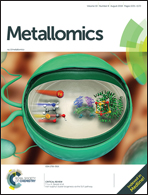Nickel(ii)-promoted specific hydrolysis of zinc finger proteins†
Abstract
In this work we demonstrate that the previously described reaction of sequence specific Ni(II)-dependent hydrolytic peptide bond cleavage can be performed in complex metalloprotein molecules, such as the Cys2His2 zinc finger proteins. The cleavage within a zinc finger unit possessing a (Ser/Thr)-X-His sequence is not hindered by the presence of the Zn(II) ions. It results in loss of the Zn(II) ion, oxidation of the SH groups and thus, in a collapse of the functional structure. We show that such natural Ni(II)-cleavage sites in zinc finger domains can be edited out without compromising the DNA binding specificity. Inserting a Ni(II)-susceptible sequence between the edited zinc finger and an affinity tag allows for removal of the latter sequence by Ni(II) ions after the protein purification. We have shown that this reaction can be executed even when a metal ion binding N-terminal His-tag is present. The cleavage product maintains the native zinc finger structure involving Zn(II) ions. Mass spectra revealed that a Ni(II) ion remains coordinated to the hydrolyzed protein product through the N-terminal (Ser/Thr)-X-His tripeptide segment. The fact that the Ni(II)-dependent protein hydrolysis is influenced by the Ni(II) concentration, pH and temperature of the reaction provides a platform for novel regulated DNA effector design.



 Please wait while we load your content...
Please wait while we load your content...